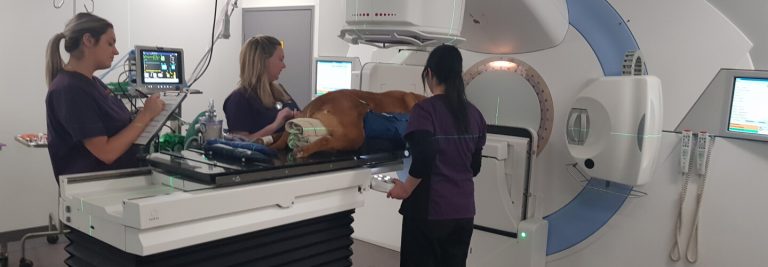Muscular Injuries in Dogs and Cats
Muscular injuries form up to 55% of all injuries in the human sporting population1. Most dogs can be considered athletes due to the frequency and intensity of their running and play. Historically, muscular injuries have been infrequently diagnosed due to the limited use of advanced imaging such as ultrasound, CT and MRI. Fortunately, as these tools have become more available in veterinary medicine, we are better able to detect subtle muscular injuries and develop clinical testing as we have done for other orthopaedic conditions such as hip dysplasia.

Muscles are partially or completely torn when some or all of the muscle fails to cope with the demands placed upon it, usually during sudden acceleration or deceleration such as in sprinting after a ball or changing direction to follow another dog. Muscles that cross two joints (biarthrodial muscles) e.g. iliopsoas, biceps brachii, gastrocnemius) are more vulnerable to strains and tears and are most commonly affected.
A number of factors predispose to muscle injury including:
- Sudden increase in the intensity of activity
- Insufficient joint range of motion
- Excessive muscle tightness
- Acute or chronic muscular fatigue (overuse)
- Muscle imbalance2
- Previous injury
- Spinal dysfunction
Physiotherapists grade muscle tears according to severity (Fig 1). Proper assessment and grading is important as early, gentle movement significantly enhances the outcome for mild to moderate strains but can cause re-rupture in grade III tears. Re-rupture is the most significant determinant of a poorer outcome and prolonged recovery in severe tears3.
Management of Muscle Injury
If your dog or cat suffers an injury, it is always important to have them assessed by a veterinarian to rule out fractures, ligament ruptures or tendon injuries and they may need an x-ray. If nothing conclusive is found and your dog or cat is still lame, it is important to have your pet assessed and diagnosed by a vet familiar with muscle injuries and/or an animal physiotherapist.
Management centres around appropriate rest, pain relief before a graduated return to normal activity and then exercise. In the first 48hrs, it is important to rest the injured area from strenuous activity though research demonstrates that frequent, low grade, pain-free muscle activation improves recovery and reduces complications.
Icing may help to reduce swelling, inflammation and improve pain and can be done as often as every 2 hours. If your pet is lame or not weight bearing on a leg normally, then they are in pain and further analgesia is likely to be required.

After the first 48 hours, it may be appropriate to start gentle, static exercises designed to strengthen local musculature, develop balance and limit stiffness. Early rehabilitation should be guided by a clinician with a background in physiotherapy or rehabilitation as incorrect activity or too much, too soon can cause further injury and pain.
As your pet progresses, the rehabilitation exercises your pet is allowed to do will become more challenging and more closely reflect the complex movements they use in running and play. For dogs or cats who struggle to regain normal movement, hydrotherapy or use of an underwater treadmill can let them build strength safely and without pain.
Similar to hamstring injuries in humans, many muscular injuries can recur so it is important for muscle tears to be fully rehabilitated before your dog returns to running, chasing and playing with you.
References
- JarvinenTAH, Jarvinen TLN, Kaariainen M et al (2007) Muscle injuries:optimising recovery. Best Practice Resident Clinical Rheumatology. 21: 317-321.
- Croisier JL, GanteaumeS Binet J et al. (2008) Strength imbalances and preventions of hamstring injury in professional soccer players: a prospective study. American Journal of Sports Medicine. 36: 1469-1475.
- Folland JP and Williams AG (2007) The adaptations to strength training. Sports Medicine 37: 145-168.
- Morelli KM, Brown LB and Warren GL (2017)Effect of NSAIDs on recovery from acute skeletal muscle injury: a systematic review and meta-analysis. The American Journal of Sports Medicine
- Figure 1: http://www.turnerequinesportsmed.com/muscle-injury-detection-and-therapies/




